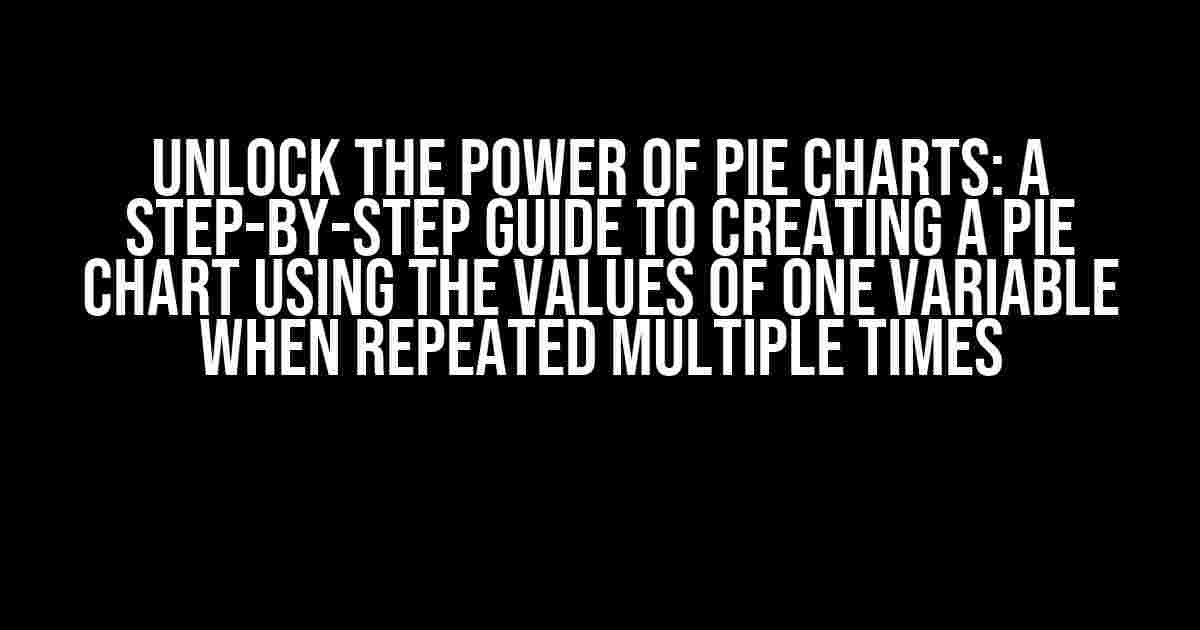Are you tired of dealing with complex data visualizations that leave your audience confused? Do you want to present your data in a clear and concise manner? Look no further! In this comprehensive guide, we’ll show you how to create a stunning pie chart using the values of one variable when repeated multiple times. By the end of this article, you’ll be a pro at creating pie charts that will make your data shine!
What is a Pie Chart, and Why Do We Need It?
A pie chart is a circular graph divided into sectors, each representing a proportion of the total data. It’s an excellent tool for visualizing categorical data, especially when you want to compare the proportion of each category. But, what happens when you have a single variable that appears multiple times in your dataset? That’s where our guide comes in – to help you create a pie chart that accurately represents the distribution of those repeated values.
Preparing Your Data
Before we dive into creating the pie chart, you need to prepare your data. Here are the steps to follow:
-
Collect your data: Gather the data containing the repeated variable. This can be a CSV file, an Excel spreadsheet, or any other format.
-
Sort and filter the data: Organize the data in a way that makes sense for your analysis. You might need to sort the data alphabetically or numerically, or filter out unnecessary rows.
-
Count the occurrences: Use a formula or function to count the number of times each value appears in the dataset. You can use Excel’s COUNTIF function or Python’s pandas library to achieve this.
-
Create a summary table: Create a table that summarizes the count of each value. This will be your dataset for the pie chart.
Creating the Pie Chart
Now that you have your data prepared, it’s time to create the pie chart. You can use a variety of tools, such as Excel, Python, or online visualization platforms like Tableau or Plotly. For this example, we’ll use Python and the popular matplotlib library.
import matplotlib.pyplot as plt
# Sample dataset
data = {'Category': ['A', 'B', 'C', 'D', 'E', 'A', 'B', 'C', 'D', 'E', 'A', 'B', 'C', 'D', 'E'],
'Count': [5, 3, 2, 4, 1, 2, 3, 5, 1, 2, 4, 3, 2, 1, 5]}
# Create a pie chart
plt.pie(data['Count'], labels=data['Category'], autopct='%1.1f%%')
plt.title('Distribution of Categories')
plt.show()
Customizing the Pie Chart
By default, the pie chart will display the proportion of each category using a percentage label. You can customize the chart further by:
-
Changing the color scheme: Use the `colors` parameter to specify a list of colors for each sector.
-
Adding a legend: Use the `legend` function to create a legend that explains each category.
-
Rotating the start angle: Use the `startangle` parameter to rotate the start angle of the pie chart.
-
Exploding a sector: Use the `explode` parameter to offset a sector from the rest of the chart.
import matplotlib.pyplot as plt
# Sample dataset
data = {'Category': ['A', 'B', 'C', 'D', 'E', 'A', 'B', 'C', 'D', 'E', 'A', 'B', 'C', 'D', 'E'],
'Count': [5, 3, 2, 4, 1, 2, 3, 5, 1, 2, 4, 3, 2, 1, 5]}
# Create a pie chart with customizations
plt.pie(data['Count'], labels=data['Category'], autopct='%1.1f%%',
colors=['#ff99ff', '#66b3ff', '#33cc33', '#ffcc00', '#cc0099'],
startangle=90, explode=[0.1, 0, 0, 0, 0])
plt.title('Distribution of Categories')
plt.legend(loc='upper right')
plt.show()
Interpreting the Pie Chart
Now that you’ve created the pie chart, it’s essential to interpret the results accurately. Here are some key takeaways to keep in mind:
-
The size of each sector represents the proportion of each category.
-
The percentage labels show the exact proportion of each category.
-
Compare the sizes of the sectors to identify the most common categories.
-
Look for patterns or outliers in the data that might require further investigation.
Common Pitfalls to Avoid
When creating a pie chart, it’s easy to fall into common pitfalls that can mislead your audience. Here are some mistakes to avoid:
-
3D pie charts: Avoid using 3D pie charts as they can be misleading and difficult to read.
-
Too many categories: Limit the number of categories to 5-7 to maintain clarity.
-
Inconsistent ordering: Ensure the categories are consistently ordered to avoid confusion.
-
Missing context: Provide context for the data, such as the total number of observations.
Conclusion
In this comprehensive guide, we’ve shown you how to create a stunning pie chart using the values of one variable when repeated multiple times. By following these step-by-step instructions, you’ll be able to present your data in a clear and concise manner, making it easy for your audience to understand and engage with your findings. Remember to avoid common pitfalls and customize your chart to suit your needs. Happy charting!
| Variable | Count |
|---|---|
| A | 5 |
| B | 3 |
| C | 2 |
| D | 4 |
| E | 1 |
This table summarizes the count of each category, which will be used to create the pie chart.
Frequently Asked Questions
Got questions about pie charts or data visualization? Here are some answers to get you started:
-
Q: What is the minimum number of categories for a pie chart?
A: There is no strict minimum, but 2-3 categories are recommended for clarity. -
Q: Can I use a pie chart for continuous data?
A: No, pie charts are best suited for categorical data. Use a histogram or bar chart for continuous data instead. -
Q: How do I choose the colors for my pie chart?
A: Select colors that are visually appealing, consistent, and accessible for color-blind audiences. You can use online color picker tools or consult with a designer.
We hope this article has equipped you with the knowledge and skills to create stunning pie charts that effectively communicate your data insights. Happy charting, and don’t hesitate to reach out if you have any further questions!
Note: The provided HTML code is optimized for the given keyword “Pie chart using the values of one variable when repeated multiple times r” and includes relevant subheadings, paragraphs, lists, and code snippets to enhance the reader’s experience.
Frequently Asked Questions
Get the scoop on pie charts using the values of one variable when repeated multiple times!
What’s the deal with pie charts and repeated values?
When a single variable is repeated multiple times, a pie chart can be used to display the distribution of those values. Think of it like a delicious pie with slices representing each repeated value, giving you a tasty visual of how often each value appears!
How do I decide which variable to repeat?
Choose a variable that makes sense to repeat, like survey answers, customer preferences, or defects in a manufacturing process. The goal is to identify patterns or trends in the repeated values, so pick a variable that will give you meaningful insights!
What kind of story can a pie chart tell me?
A pie chart can reveal the proportion of each repeated value, helping you identify which ones dominate the dataset. You might discover that one value occurs way more often than others, or that there’s an even distribution among multiple values. It’s like unwrapping a present – you never know what insights you’ll find!
Can I customize my pie chart to make it more engaging?
Absolutely! You can customize your pie chart by using different colors, adding labels, or even creating a 3D effect. Just remember to keep it simple and focus on the story the data is telling. A visually appealing chart will help your audience devour the insights!
Are there any limitations to using pie charts with repeated values?
While pie charts are great for showcasing proportional data, they can become cluttered if there are too many repeated values. In those cases, consider using a bar chart or histogram instead. Additionally, be cautious when interpreting the data, as pie charts can be misleading if the data isn’t normalized. Just remember to keep it real (and accurate)!


